
![]()
~ ST. THOMAS CHURCH ~
59 BURGATE STREET, CANTERBURY
ROMAN CATHOLIC
"Thus, in making the foundations of the Roman Catholic Church, a well was found with clear water in it, covered over at some depth, and a Roman millstone at or near its mouth...." JB
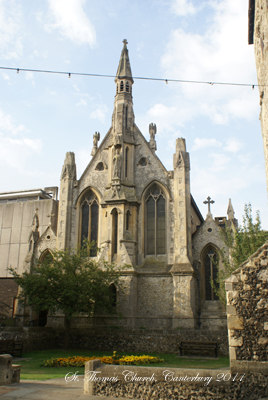
The British Architect - Canterbury - New Roman Catholic Church - The foundation stone of a new church, dedicated to St. Thomas of Canterbury and intended to be used by the Roman Catholics of this city, was laid by the Duke of Norfolk last week. The site of the new edifice lies at the back of the dismantled church of St. Mary Magdalene in Burgate, and the design for the building, which will be in the early decorated style of architecture, consists of nave with side aisles, sanctuary, three side chapels, two confessionals, priests' and boys' sacristies, reliquary room, organ chamber and a baptistry. The nave will have a height of 42 feet to the centre of the roof, and its area will, it is estimated accommodate from 450 to 500 persons. There will be a spire rising to the height of 76 feet from the ground. The foundations, which are already laid, are of considerable dimensions, and have a depth varying from 14 to 26 feet on account of the nature of the ground. The front of the superstructure will consist of brick, faced with Kentish rag, and having Bath stone dressings. The remainder will be built of white stock bricks with similiar dressings. The building is estimated to cost about £4000, and will be completed in about twelve months. Mr. J. G. Hall is the architect, and Messrs. Gaskin and Goddin have the contract for the erection of the building. May 29th, 1874
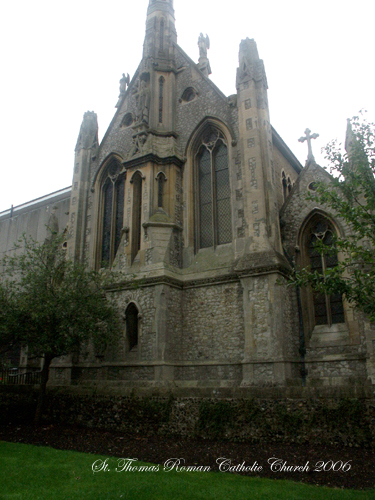
A recent photograph of St. Thomas church
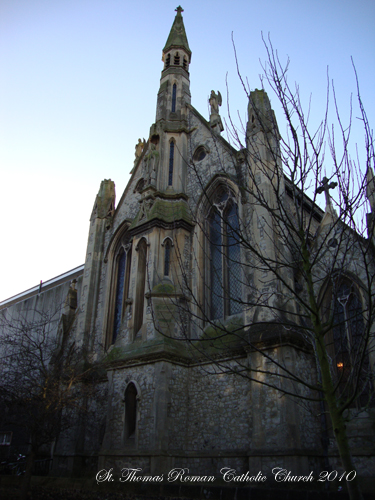
In Burgate Street is a modern church with a rich interior. It was opened in 1875 by Cardinal Manning.
Handbook for Canterbury British Association Dover 1899
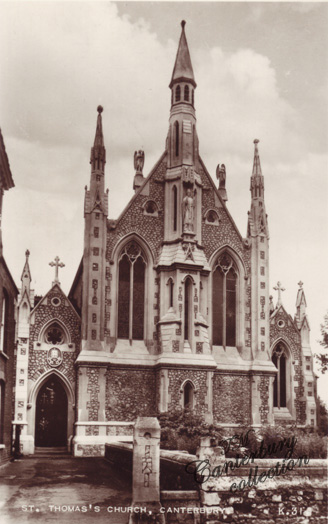 _____
_____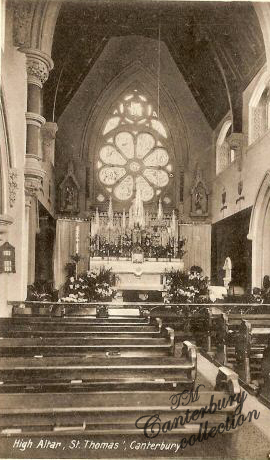
The front of St. Thomas's church and a picture of the High Altar, from old postcards
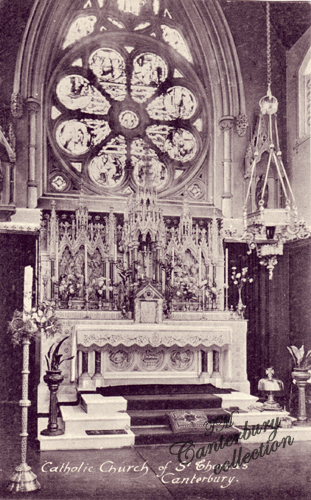
"The Catholic Church of St. Thomas, situate in Burgate, is a building of Kentish rag with Bath stone dressings, from designs by J.G. Hall esq. Assoc. Mem. Inst. C.E. architect of this city; the facade is peculiarly beautiful and has statues of its patron saint and of two angels, on on either side:
 _____
_____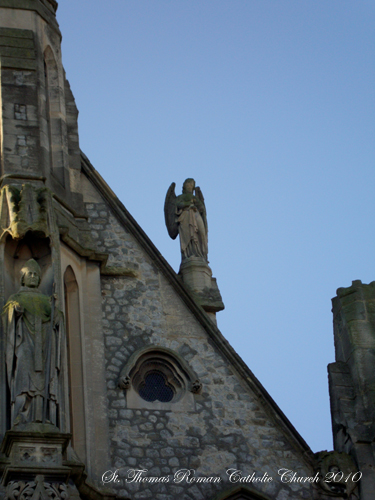
the high altar is surmounted by a carved canopy, which is again backed by a reredos in two panels, representing in alto relievo groups the Death of St. Thomas, and the Penance of King Henry II.: the canopy, supported on four columns of marble, guards more especially the tabernacle: this is of polished alabaster, with gemmed and gold doors, surrounded by glittering spar work: high above tower the delicate pinnacles with tracery and sculpture of exquisite design: there are several other altars, one is dedicated to St. Thomas and the beautiful shrine which reposes thereon (containing relics of the saint), is a facsimile of the original shrine which formerly stood in the cathedral; the other altars are dedicated to the Blessed Virgin, St. Joseph, Saints John and Lucia, St. Gregory the Great, the Sacred Heart and St. Augustine: the baptistry contains a very beautiful font with carved oak canopy, the work and gift of Mr. Horan, one of the citizens: the east window is stained and represents in eight compartments, each containing a medallion, events in the life of St. Thomas; there is a convenient approach to the church from Burgate street, by ornamental iron gates. It has sittings for 500." 1882
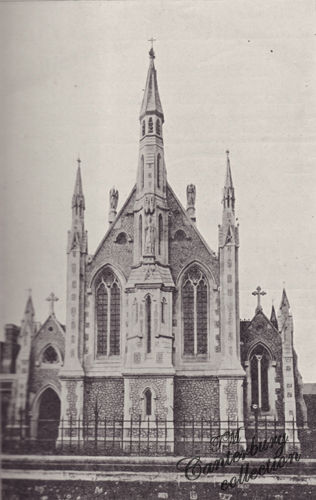
"The Catholic Church of St. Thomas is an attraction to the visitors of the city. This handsome church is built of Kentish Rag, with Bath stone dressings, from the designs by the late Mr. J.G. Hall*, architect of this city. The facade is peculiarly beautiful, and the sculpture of the statue of its Patron Saint, and of two Angels, one on either side, which fills the three principal niches are worth of close examination. The interior is very striking, and every Altar worth a visit. The High Altar is surmounted by a carved canopy, which is again backed by reredos in two panels, representing in Alto Relievo groups, the death of St. Thomas, and the King's Penance. The canopy supported on four columns of marble guards more especially the Tabernacle, this is of course a very important object, and is composed of polished alabaster, with gemmed and gold doors, surrounded by glittering spar work.
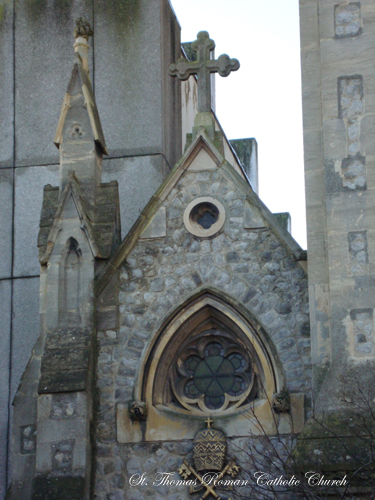
High above, tower the delicate pinnacles, with tracery and sculpture work of exquisite design there are several other altars, but it would take too much space to detail the beauties of each chapel, we may however, call the visitor's attention tot he altar dedicated to St. Thomas, and the beautiful shrine which reposes thereon (containing relics of the Saint,) and a facsimile of the original shrine, formerly in the Cathedral. The other altars are dedicated to the Blessed Virgin, St. Gregory the Great, the Sacred Heart, and St. Augustine. As the visitor passes these shrines coming down the right aisle, he faces the Baptistry, which contains a very beautiful Font, the work and gift of Mr. Horan**, one of our fellow citizens, this, with its highly carved Oak canopy forms one of the most noticeable features in the building. It is from the bottom of the church that the East Window of stained glass above the High Altar is seen in its greatest perfection; this adds greatly to the beauty of the interior, as the colours warm and soften the massive pillars and delicate fret work. The window is in eight compartments, each compartment containing a Medallion in stained glass, illustrating some event in the life of St. Thomas, and amotto or device, in scroll work with flowers, the smallest spaces are filled in with appropriate designs, the large middle round having a representation of the Pelican, the chief middle and side compartments of the window above the rose being filled in by a representation of the First Person of the Trinity and worshipping Angels.
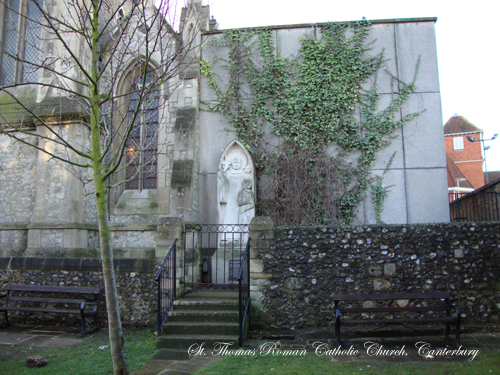
There is a convenient approach to the church from Burgate street by ornamental iron gates. It may here be remarked that this church is one of the most perfect modern structures in England."
"Goulden's Guide to Canterbury and the Cathedral" H. J. Goulden c. 1900
*John G. Hall (possibly George), he was born c. 1834
**most likely George Michael Horan, Stone Mason, born Canterbury c. 1844
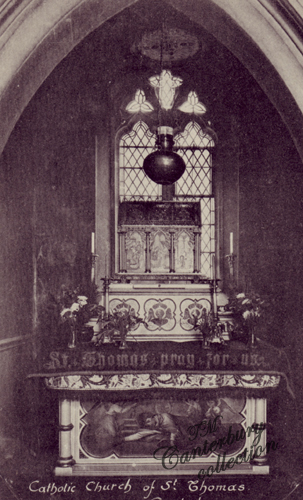
"The modern Roman Catholic church of St. Thomas the Martyr, on the left hand of Burgate Street going towards the cathedral, is a somewhat handsome, showy structure of Kentish rag with Bathstone dressings; it is worth visiting to see the beautiful shrine of St. Thomas, which is a fairly successful attempt to reproduce certain features of the original world-renowned shrine which formerly stood in the cathedral."
"Canterbury; A history of the ancient city" J. Charles Cox 1905
Mary Hales presented two relics of St. Thomas to the St. Thomas's Church, these were from Gubbio in Umbria, Italy. One was a piece of the vestment and a piece of bone from the body.
 _______
_______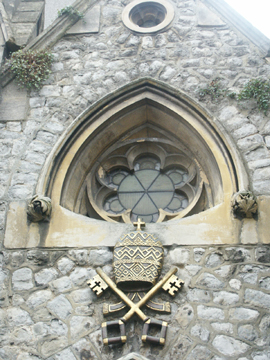
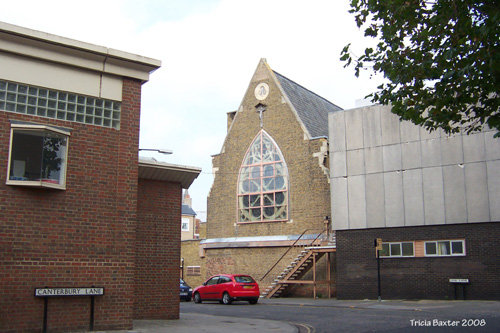
Canterbury Lane junction with Link Lane, showing the rear of St. Thomas Roman Catholic Church
![]()
*there was a Catholic Chapel in Burgate in 1858, Rev. J. Colgan
1861 Thomas Richardson, Roman Catholic Priest, Burgate St.
1875 - We understand that a new organ of two manuals, with bourdons, 13 stops, prepared for 18, has been erected in the church of St. Thomas a Becket, Canterbury, by J. Grover of the "Hall," Providence Place, Shepherds Bush.
1882 - Rev. Richard Power priest. Hours of Service: 9:30 am 6 pm daily, 8 am; Thurs. 8 pm.
1903 - Rev. Richard Power, priest. Hours of service: 9 & 11 am & 6:30 pm; daily, 8 am; Thurs 8 pm; holy days, 8 & 10 am.
1917 - Services; Sun. Mass, 8 and 10:45; Evening Service, 6:30. Holy days, Mass, 8 and 10. Weekdays, Mass, 8; Thurs, Evening Service 6. Rev. Edmund H. Sheppard; Rev. R. Power (retired)